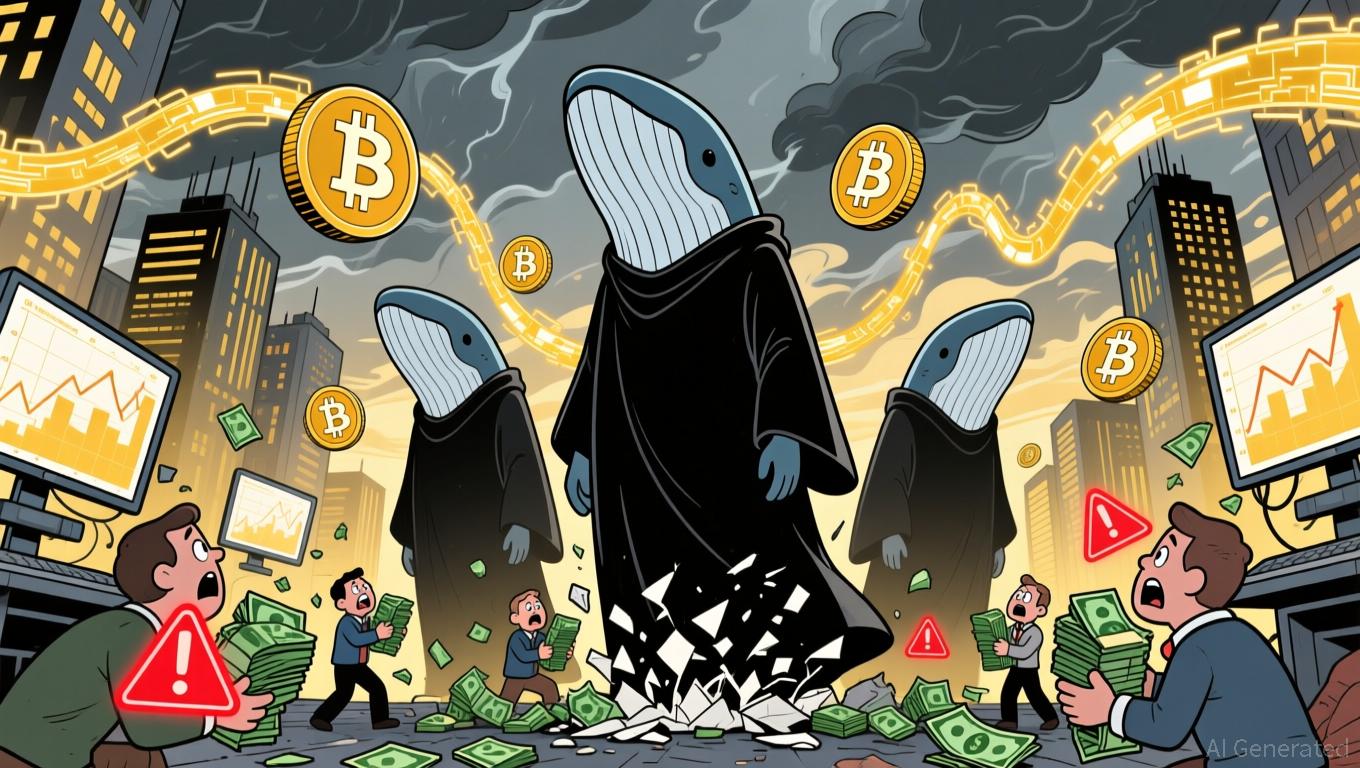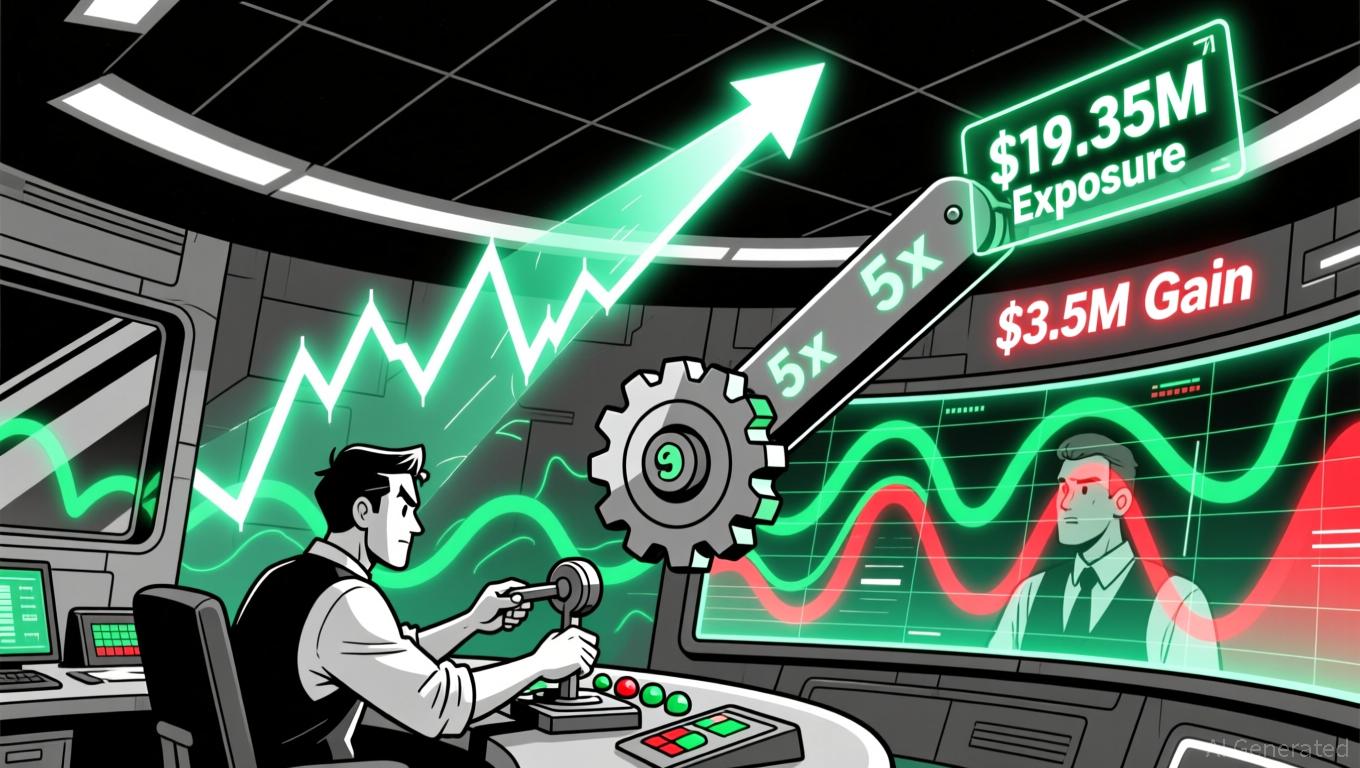News
Stay up to date on the latest crypto trends with our expert, in-depth coverage.
- TWT (TNSR) token's value collapsed after Coinbase absorbed Vector.fun, stripping its trading infrastructure and utility. - Price surged 37.3% post-acquisition but plummeted as governance token lost revenue streams and real-world use cases. - Contrast with YouBallin's $YBL token, which creates utility through fan engagement and cross-chain liquidity incentives. - Investors warned to prioritize tokens with transparent economic models tied to measurable on-chain activity over speculative governance rights.

- DoorDash's DASH stock rose 5.42% on Nov 22 2025 amid earnings reports and strategic expansion efforts. - The company expanded delivery partnerships with Family Dollar/Old Navy and integrated Coco Robotics' autonomous services. - Analysts estimate $275.20 fair value, citing growth potential but warning of execution risks in new markets. - Despite short-term volatility, DoorDash maintains 242% three-year shareholder returns with 189M active users.

- Bitcoin fell to $80,500 in November 2025, sparking debate over market bottom signals amid mixed technical indicators and whale resilience. - On-chain data shows miners and long-term holders avoid selling, while retail sell-offs and Fed policy uncertainty complicate recovery prospects. - Geopolitical tensions and crypto-linked sanctions evasion amplify volatility, contrasting with institutional participation via leveraged ETFs and transparency tools. - Analysts remain divided: some highlight historical pa
- ZK technology stocks surged amid institutional adoption and quantum threat concerns, despite no recent regulatory updates or protocol announcements. - Institutional demand for privacy-preserving infrastructure grew, highlighted by Coinbase's security-focused wallet migration and post-quantum readiness discussions. - Market momentum reflects anticipation of future ZK protocol upgrades and cross-sector innovation, though regulatory ambiguity creates both risks and opportunities. - Analysts debate whether t
- Astar 2.0, a next-gen DeFi platform, leverages hybrid AMM-CEX models and AI-driven tools to enhance cross-chain liquidity and smart contract security. - The platform achieved $1.399B TVL and $27.7B daily volume in Q3 2025, with strategic partnerships and integrations across BNB Chain, Ethereum , and Solana . - AI-enhanced auditing modules and EVM compatibility address 89% of DeFi contract vulnerabilities, driving 20% QoQ growth in institutional wallet adoption. - Tokenomics 3.0 caps ASTR supply at 10.5B
- Vitalik Buterin endorses ZKsync's Atlas upgrade, highlighting 15,000 TPS, $0.01 fees, and bridging Ethereum's Layer 1/2 liquidity. - ZK Stack innovation reduces capital fragmentation while Airbender prover enables 2-GPU L1 block proofs, advancing Ethereum's scalability. - ZKsync now holds 15% Layer 2 TVL with 50% ZK token surge, but faces 60x performance gaps and competition from Arbitrum/Optimism. - Upcoming Fusaka upgrade targets 30,000 TPS by December 2025, while Kohaku privacy framework addresses ado
- ZK Atlas Upgrade (Oct 2025) boosts blockchain scalability via modular ZK solutions, enabling 15,000–43,000 TPS with $0.0001 per transaction costs. - Ethereum gas fees dropped 90%, TVL in ZK rollups hit $3.5B by 2025, with Deutsche Bank adopting ZK-rollups for institutional settlements. - Deflationary tokenomics drive capital efficiency: buybacks, burns, and staking rewards attract institutions, supported by $15B in Bitcoin ETF investments. - Analysts project 60.7% CAGR for ZK Layer-2 solutions, reaching

- ZEC surged 6.32% in 24 hours to $538.2 on Nov 22, 2025, despite a 9.7% weekly drop, with 36.25% monthly and 879.76% annual gains. - A $19.35M ZEC long position on Hyperliquid (5x leverage) shows $3.5M unrealized gains, highlighting institutional bullishness amid price volatility. - The leveraged position underscores amplified risks/rewards, with narrowing gains signaling market uncertainty and the need for cautious monitoring of macroeconomic/on-chain trends.

- BlackRock's IBIT Bitcoin ETF recorded a record $523M outflow, pushing November's total U.S. spot Bitcoin ETF redemptions to $2.96B amid Bitcoin's 30% price drop. - Analysts link the exodus to weak fundamentals and macroeconomic uncertainty, with ETF outflows and long-term holder sales tightening liquidity and eroding investor confidence. - BlackRock filed for an Ethereum staking ETF as stablecoins surge in cross-border finance, processing $9T in 2025 payments while Bitcoin ETFs face sustained outflows an
- Zcash (ZEC) surged 472% to $420 in 2025, driven by institutional adoption and regulatory clarity under the U.S. Clarity Act. - Grayscale's $137M Zcash Trust investment and Cypherpunk's $18M treasury boost signaled institutional confidence in privacy coins. - Zcash's dual-mode privacy features attracted investors fleeing Bitcoin's transparency, with 30% of its supply now in shielded pools. - Regulatory risks persist, including potential FinCEN crackdowns on shielded transactions, despite the Clarity Act's
- 09:58Bitcoin market capitalization rebounds to surpass $1.7 trillion, rising to 8th place among global assetsAccording to ChainCatcher, bitcoin's market capitalization has rebounded and surpassed 1.7 trillion USD, currently reported at 1.72 trillion USD. It has overtaken the Vanguard Total Stock Market ETF (1.703 trillion USD), rising to 8th place in the global asset market capitalization rankings.
- 09:43Tom Lee: Shorting MSTR has become the market's preferred hedge against declines, revealing deeper structural issues.BlockBeats News, November 23, BitMine Chairman and CEO Tom Lee stated that a certain exchange has become the preferred tool for crypto investors to manage risk, which partly explains why its stock price has dropped 43% over the past month. "Strategy may be the most important indicator to watch right now, as it is both a bitcoin proxy stock and the most liquid alternative asset," Lee said in an interview with CNBC on Thursday. Due to the limited tools available to directly hedge losses in the crypto market, institutional traders have turned to shorting the stock of a certain exchange. The company holds nearly 650,000 bitcoins, making its stock price closely tied to bitcoin's performance. "In my view, when crypto market participants try to hedge losses in their bitcoin and ethereum positions, they have no other way to hedge except by shorting its liquid alternative stock—and this exchange is the best choice," Lee explained. He added that native hedging tools such as bitcoin and ethereum derivatives lack sufficient liquidity for large funds, "Any investor holding a large-scale long position in bitcoin... has very limited hedging capability in the crypto derivatives market." But this exchange provides a workaround. "Investors can use the highly liquid options chain of this exchange to hedge all crypto asset risks," Lee pointed out. "Essentially, this exchange is absorbing all the hedging pressure generated by the entire crypto industry to protect long positions." Lee also mentioned the lingering impact of the October 10 market crash, which wiped out $20 billions in market value and destroyed the exchange's liquidity. "This completely devastated market makers," he called market makers the "central banks" of the crypto market. Since then, systemic cracks have persisted, and the liquidity of altcoins, mining stocks, and bitcoin proxy assets such as this exchange remains thin. In the current downturn, MSTR is one of the hardest-hit targets. Lee believes this is partly because it has taken on the role of the market's "pressure valve." He pointed out that the underlying structure of the crypto market remains fragile, and the phenomenon of this exchange becoming a hedging tool is revealing deeper structural issues.
- 09:43Benson Sun: Multiple bottoming signals have been observed, and the market has fully priced in the negative expectation of MSTR being removed from the index.BlockBeats News, on November 23, crypto KOL and former FTX community partner Benson Sun posted on social media that his quantitative long positions had been paused since the stop loss at $90,000, and have just now been restarted. He has observed multiple bottoming signals and expects a wide-ranging supply-demand balance zone to form here, which provides enough volatility for quantitative strategies to conduct swing trading. As for MSTR being removed from the index, he believes the market has already fully priced in this expectation—now, this kind of illogical sharp decline is essentially no different from already being removed from the index. He is still holding his long positions with an average entry price of $81,500 and will continue to hold until overall liquidity dries up before exiting.